let’s meet & talk today
E-Demic Project

Privacy Preserving - Proximity Contact Tracing
National Patent Number: AL/P/2020/000294 -Distributed and Decentralised Contact Tracing Algorithm that Preserves Privacy for Smartphones, Portable Devices, Computers; Systems & Methods.
Patent Owner: Think Bank Albania Foundation
 The recent explosion of COVID-19 disease has forced WHO to raise its risk to “Pandemic”. It has forced many countries to enact severe to drastic lockdown measures in an attempt to create the necessary “social distancing”. It has also forced many governments to allocate huge amounts of money for facing this health and economic emergency in their respective countries. The pandemic is also putting high level of stress to public health institutions, and to countries’ Emergency Response organisations. It is now generally accepted, that the only way to fight this kind of infectious disease is by stopping its spread among the population, by lowering the “R0” factor below 1.
The recent explosion of COVID-19 disease has forced WHO to raise its risk to “Pandemic”. It has forced many countries to enact severe to drastic lockdown measures in an attempt to create the necessary “social distancing”. It has also forced many governments to allocate huge amounts of money for facing this health and economic emergency in their respective countries. The pandemic is also putting high level of stress to public health institutions, and to countries’ Emergency Response organisations. It is now generally accepted, that the only way to fight this kind of infectious disease is by stopping its spread among the population, by lowering the “R0” factor below 1.

The most difficult task at stopping its spread has proved to be the identification of infected persons’ movements and contacts with healthy people, which were potentially infected, and the identification, isolation and medical testing of those persons.
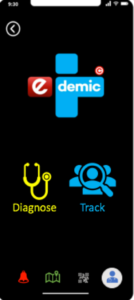
In an attempt to facilitate all above tasks, TBA is proposing the development of an innovative mobile app and associated desktop software (e-Demic) that will enable WHO, all governments and all public health institutions, to instantly trace back all movements and contacts of “diagnosed” or “potentially infected” people, monitor quarantined or self-isolated people, with great ease and accuracy. These apps be classified in two categories: 1) those that track violations of self-isolation of infected people and 2) those that track movements of people and try to identify past contacts. The first is already incorporated in e-Demic, in a much sophisticated and useful way. The second is the main objective of e-Demic, and none of the apps that have been created so far has the same guarantee of privacy, accuracy and anonymity as e-Demic.

E-Demic uses Bluetooth LE, much like the other apps or PEPP-PT, but it does not use the server to identify past contacts, thus removing the possibility for anyone to reverse engineer the pseudorandom identifiers. E-Demic sends the encrypted list of pseudorandom identifiers to other apps, which will conduct their own proximity checking and user alerting, without storing them in the server. This way, no-one, not even the administrators of the server, will be able to find any personal information. The only data that will remain in the server will be a patient number for statistical purposes and the date of infection or recovery. All the above technologies rely on the user enabling Bluetooth on their phone, and keeping it “Discoverable”. If Bluetooth is not enabled or “Discoverable” the above apps will be totally ineffective.
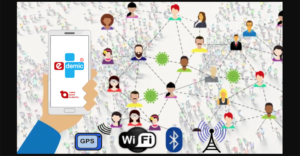 To account for such possibility, e-Demic uses two more technologies, with the assumption that at least one of the three will be activated by the user or the operating system. E-Demic uses GPS and Wi-Fi signals, always with the consent of the user. GPS coordinates are stored in the app and are not send to the server. WiFi identifiers that are broadcasted by Hotspot WiFi beacons are also stored in the app together with their distance, measured in the same way as the Bluetooth distance. E-Demic traces all Wi-Fi access points, storing their public MAC address and distance from the phone, which is calculated with the “Round-Trip Time” method, or through the signal strength. e-Demic uses a proprietary method for calculating the distance between two smartphones based on their distances from several Wi-Fi access points, which makes it uniqueWhen the user is found infected, with his consent, these databases are encrypted and sent to other apps. It is important to emphasise that the server does not store any user data, which in no time is available to anyone, including system administrators.
To account for such possibility, e-Demic uses two more technologies, with the assumption that at least one of the three will be activated by the user or the operating system. E-Demic uses GPS and Wi-Fi signals, always with the consent of the user. GPS coordinates are stored in the app and are not send to the server. WiFi identifiers that are broadcasted by Hotspot WiFi beacons are also stored in the app together with their distance, measured in the same way as the Bluetooth distance. E-Demic traces all Wi-Fi access points, storing their public MAC address and distance from the phone, which is calculated with the “Round-Trip Time” method, or through the signal strength. e-Demic uses a proprietary method for calculating the distance between two smartphones based on their distances from several Wi-Fi access points, which makes it uniqueWhen the user is found infected, with his consent, these databases are encrypted and sent to other apps. It is important to emphasise that the server does not store any user data, which in no time is available to anyone, including system administrators.
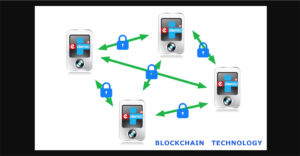 Once a user is diagnosed positive, they can send their encrypted data, using blockchain technology, to all other e-Demic users, without storing user data on server. Blockchain ensures that encrypted data are sent peer-to-peer, without anyone being able to decrypt the data, tamper it, or store it somewhere. Anonymised encrypted data and decentralised tracing using blockchain technology, makes e-Demic privacy and anonymity better than all other apps.
Once a user is diagnosed positive, they can send their encrypted data, using blockchain technology, to all other e-Demic users, without storing user data on server. Blockchain ensures that encrypted data are sent peer-to-peer, without anyone being able to decrypt the data, tamper it, or store it somewhere. Anonymised encrypted data and decentralised tracing using blockchain technology, makes e-Demic privacy and anonymity better than all other apps.
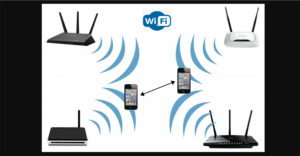
Once the e-Demic receives the encrypted databases of an infected user, if Bluetooth data is not available for whatever reason, it extracts the data and calculates the distance between the infected person and the user of the app, as well as the time spent at that distance. e-Demic also uses an algorithm protected by a patent to calculate the distance between the two users based on their distance from the same Hotspots, which they have been close to. This method is used if both Bluetooth and GPS data are not available.

The distributed and decentralised method of contact tracing ensures that no data is stored on the server at all times, and no ill-intentioned person, spying on occasional data transmission from mobile phones, can get any personal information from this app. The mobile app is being designed for all operating systems and will be free for everyone. In the ideal scenario, the mobile app will be installed by all smartphone users, worldwide, to ensure full coverage and protection.
The desktop software will be available only to WHO, to governments and to public health institutions, such as health ministries of any country, public hospitals (or private hospitals authorised by country’s ministry/department of health).
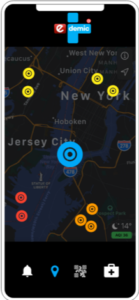 To the opposite of all other apps that are being developed, e-Demic uses Bluetooth and Wi-Fi together with AI inside the app, so that data does leave the mobile of the user, until he is diagnosed positive by an approved hospital. In such case, with the approval of the user, the location and the phone number of the infected person can be sent to the closest hospital desktop software, in encrypted form, so that the hospital can contact him for medical checking. This is done by the user with the touch of a button on the smartphone screen, or (depending on legal approvals by each government) automatically by the app itself.
To the opposite of all other apps that are being developed, e-Demic uses Bluetooth and Wi-Fi together with AI inside the app, so that data does leave the mobile of the user, until he is diagnosed positive by an approved hospital. In such case, with the approval of the user, the location and the phone number of the infected person can be sent to the closest hospital desktop software, in encrypted form, so that the hospital can contact him for medical checking. This is done by the user with the touch of a button on the smartphone screen, or (depending on legal approvals by each government) automatically by the app itself.
The mobile app will automatically (without interacting with the server) identify possible past contacts of any user with infected people and will alert the user in case he has come in contact with an infected person, prompting the user to isolate himself and to call the local doctor/emergency service. The mobile app can also identify contacts with “first-hand” and “second-hand” “potentially infected” people, and alert the user to take the required actions, as specified by each country’s ministry/department of health.
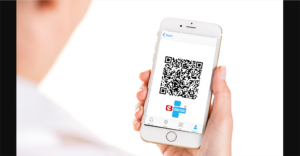
The mobile app can have the option to alert any user that may be in the vicinity of a “diagnosed” or “potentially infected” person, prompting the user to protect himself and/or move away from that location. The option can be customised to not show the vicinity of people, but to show the approximate locations where an infected user has spent more than 10 minutes, with the assumption that such places might have been contaminated. This feature can be adjusted by each country, in accordance with their privacy legislation, and can be enabled or disabled by the country’s top health organisation (typically the ministry/department of health).
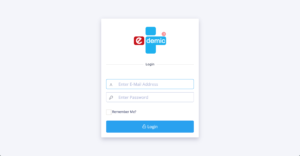 The desktop software, for use by public health institutions only, will be web-based in order to avoid storing any data in local desktops and eliminate any concern with breach of privacy. The web-based software will display the location of infected people, the location and phone number of “possibly infected” people and the location of “potentially contaminated” buildings and public transportation vehicles. The web-based software will allow instantaneous statistics at country or at worldwide level at the click of the mouse. It will also allow WHO or a country’s ministry/department of health to initiate or terminate the alert for a new epidemic and raise it at any desired risk level.
The desktop software, for use by public health institutions only, will be web-based in order to avoid storing any data in local desktops and eliminate any concern with breach of privacy. The web-based software will display the location of infected people, the location and phone number of “possibly infected” people and the location of “potentially contaminated” buildings and public transportation vehicles. The web-based software will allow instantaneous statistics at country or at worldwide level at the click of the mouse. It will also allow WHO or a country’s ministry/department of health to initiate or terminate the alert for a new epidemic and raise it at any desired risk level.
E-Demic can also help public health authorities with the surveillance of self-isolated “diagnosed” people and self-quarantined “potentially infected” people. It can show alerts if any of them violates the isolation, both at the desktop software of the closest health institution and at the mobile app of the isolated person.
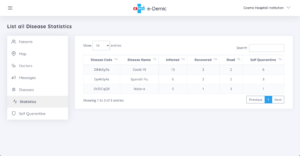
E-Demic will also have the possibility to serve as a “permit to circulate” for all users, and will greatly facilitate the task of law enforcement people in ensuring that people have the right to circulate while respecting all restrictions set by each government.
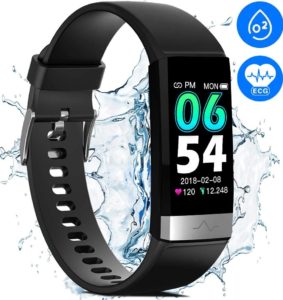 TBA is also developing an optional wearable device (will be sold apart), that will be paired to e-Demic, and will measure real-time health parameters of the user. These health parameters will be analysed by AI in the app and, when AI identifies health parameters in line with disease conditions, the app will alert the user and prompt him to contact the closest hospital. It will also be possible to alert the hospital at the touch of a button on the mobile screen, and send the measured health parameters to the hospital, so that the hospital may evaluate the degree of emergency.
TBA is also developing an optional wearable device (will be sold apart), that will be paired to e-Demic, and will measure real-time health parameters of the user. These health parameters will be analysed by AI in the app and, when AI identifies health parameters in line with disease conditions, the app will alert the user and prompt him to contact the closest hospital. It will also be possible to alert the hospital at the touch of a button on the mobile screen, and send the measured health parameters to the hospital, so that the hospital may evaluate the degree of emergency.
Finally, e-Demic can be used to fight the spread of any future epidemic or pandemic that can hit the planet, not only that of COVID-19, and it can handle several diseases simultaneously.
While TBA is aware that not everyone owns a smartphone, and not everyone carries his smartphone with him at all times, we believe that this app will facilitate the task of public health organisations for at least 80% of the developed countries population.
HOW TO SUPPORT THIS ON-GOING PROJECT?
By Online Giving:
For THIS project
Contact us today!
our building
Address
Fondacioni ‘THINK BANK ALBANIA’, Rr: NEXHO KONOMI, REZIDENCA GREEN CITY, PA4, ZYRA 1, NJB 7, TIRANA, ALBANIA.
Fiscal Code/NIPT: M0414452M
CAll us
Phone
+355 68 337 0083 | +355 67 600 4100
![]() +1 (908) 887-2651
+1 (908) 887-2651
![]() think.bank.albania
think.bank.albania
